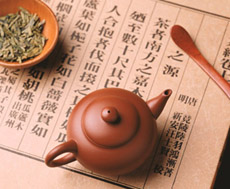Try Chinese teahouses
Updated: 2007-02-25 11:35
 China cannot be separated from its richly developed tea culture. While no one can refuse sitting back and enjoying a fragrant tea at home, people also love to go to teahouses. At teahouses, you can not only enjoy tea but also the companionship of others, combined with a bit of fun. Over time, teahouses have become part of the life and culture of many places across China. Beijing alone is host to over five hundred tea houses of various styles. Today, I'm going to take you to a teahouse in Beijing that has a strong Beijing folk culture flavor.
China cannot be separated from its richly developed tea culture. While no one can refuse sitting back and enjoying a fragrant tea at home, people also love to go to teahouses. At teahouses, you can not only enjoy tea but also the companionship of others, combined with a bit of fun. Over time, teahouses have become part of the life and culture of many places across China. Beijing alone is host to over five hundred tea houses of various styles. Today, I'm going to take you to a teahouse in Beijing that has a strong Beijing folk culture flavor.
A loud announcement in the Beijing dialect from doormen dressed in traditional Chinese Changsam welcomes me to the Tianqiao Le teahouse. Round wooden pillars support the protruding balconies fashioned according to ancient Chinese style. Black and white documentary photos of old Beijing folk artists line the white wall. Beneath a small stage, ancient style rectangular tables and chairs occupy most of the hall that is this teahouse. This could have been a typical place a hundred years ago—some place our great-great-grandfathers might have been found sipping tea and eating snacks while watching a Peking opera performance—you know, a scene we often see in the movies.
Located near the old Tianqiao area in the southern part of Beijing, the teahouse's structure, a single building made entirely of wood, is said to have been built in 1933 by a warlord. Today, as much of Chinese Vaudeville is revived on its stage, this has also become an important spot for people to reminiscence about old Tianqiao folk culture.
Having already spoken so much about Tianqiao let me brief you a little bit about this particular area of Beijing. The Tianqiao region was once the bustling hub of cultural and business activities in Beijing. Particularly, for centuries the area served as the center for grassroots entertainment. Tianqiao was filled with tea houses and opera houses, restaurants and small businesses, and street venders. It provided a place for folk artists to make a living—some ground on which they could present their most impressive skills. Zhang Fuyan, manager of the Tianqiao Le teahouse, spent his childhood on old Tianqiao's streets.
"In the old times, those who wanted to earn a living in Tianqiao had to possess special skills. That's why we've got so many great folk artists here who excel with their own individual specialty. Tianqiao is a cradle for folk artists. Crosstalk master Hou Baolin made his mark here and wrestler Bao Shanlin also become famous here."
However, as Chinese society has progressed, artists have moved into office buildings and businesses have moved into department stores. Tianqiao is no longer the way it used to be. Still, a lot of people still hold onto the idea of old Tianqiao. Zhang Fuyan said his tea house provides a fine outlet for those with certain nostalgia for the area, complete with Jasmine tea and traditional snacks.
"Every evening, we invite a lot of folk artists to perform typical Tianqiao Vaudeville. Our programs mainly aim to reflect the ancient grassroots culture of Tianqiao. Maybe some of our programs, for instance our acrobatic stunts, might not be as refined or as sophisticated as those featured on TV. Still, they capture the essence and unique flavor of old Tianqiao."
|
||
|
||
| Eating out:
Arriba arrives in the Wu
Bars&Cafes: Mare's milk a-go-go Weekend&Holiday: Ancient sites re-open after renovation Shopping: Jimmy Choo comes What's on: New shows on stage |
|
||
| Eating out:
Moroccan roll
Bars&Cafes: A boonna in training Weekend&Holiday: Pop power Shopping: LV boutique in E. China closed for disqualification What's on: Jazz-infused journey through Kunqu Opera |



